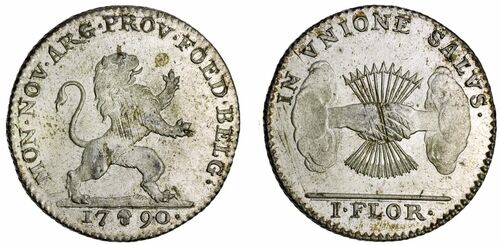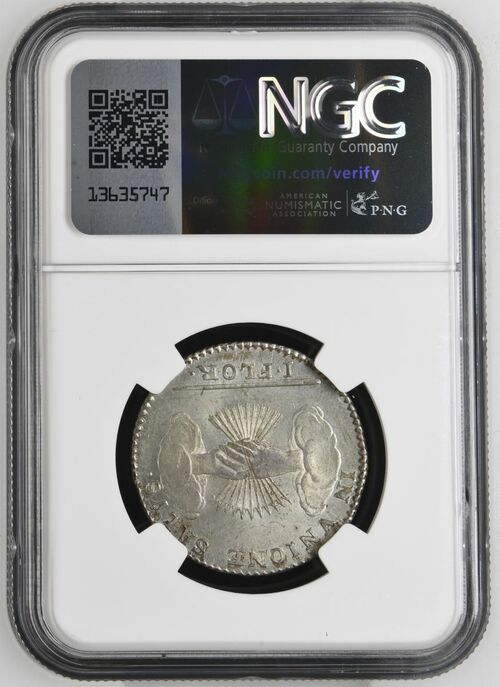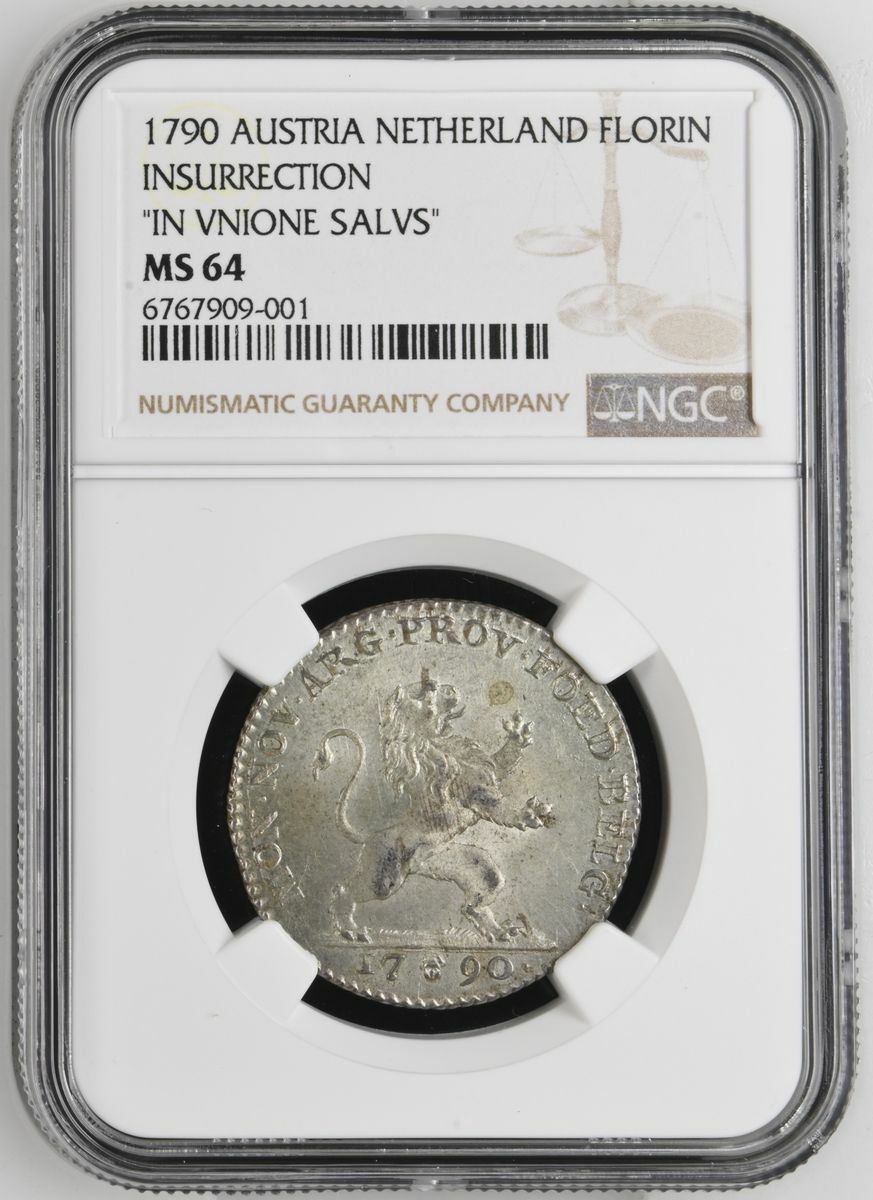Auction: 23006 - The Official COINEX Auction at Spink
Lot: 583
The Wilhelm Hüffer (1821-1895) Collection | NGC MS64 | Austrian-Netherlands, United States of Belgium, Insurrection Coinage, Florin, 1790, 'Onion' Type, MON • NOV • ARG • PROV • FOED • BELG • lion rampant right, date divided by head of angel, rev. IN VNIONE SALVS, clasped hands holding bundle of arrows, value in exergue, edge obliquely milled, 9.37g, 6h (W.1157; VH 867; KM 48), adjustment marks in centres and die wear to high points, otherwise flashy lustre to somewhat matte surfaces, a pleasingly extremely fine and much as issued, the amusing first type before the reverse legends were amended, in NGC holder, graded MS64 (Cert. #6767909-001)
Provenance
The Wilhelm Hüffer (1821-1895) Collection of European Coins and Medals
with his envelope
https://www.ngccoin.com/certlookup/6767909-001/64/
In 1789, the Brabant Revolution started in the Austrian Netherlands, as a result of unhappiness towards reforms made by Holy Roman Emperor Joseph II of the house Habsburg-Lorraine. Upon coming to power in 1780, he quickly began introducing great swathes of state, religious and social reforms. He was a liberal who wanted to secularize education, open it up to the masses and reduce the amount of state power given to the clergy. He granted more religious freedom under the Patent of Tolerance in 1781, abolished the death penalty, sought to end serfdom and wished to unify the imperial states by standardising bureaucracy, law and language.
As discontent for such changes grew, from wealthy estates in Brabant and Flanders, riots began and eventually manifested into an armed revolt. A revolutionary alliance formed between liberals, conservatives and the church, and it was leaders such as lawyers Hendrik Van der Noot (conservative - Statists) and Jean-François Vonck (liberal - Vonckists) that would eventually raise a militia to overthrow imperial power.
The Battle of Turnhout in November 1789 would prove to be the ignition for the entire Brabant Revolution. A small force under Van der Noot defeated the Austrian forces, who subsequently retreated to strongholds in Luxembourg and Antwerp. Brabant was declared independent and soon other provinces in the Austrian Netherlands followed. On 11th January 1790, the eleven free states officially unified, formed The United States of Belgium, Meanwhile the broken Emperor Joseph died powerless the following month, asking that his epitaph read 'Here lies Joseph II, who failed in all he undertook'.
After receiving coinage rights, the United Belgian States decided to mint various denominations, divided up into Liards, Sols and Florins, all designed by Theodore Van Berckel, engraver at the Brussels Mint. During the Revolution, Berckel had continued to work on dies for Joseph II, but quickly put into circulation new copper and silver currency once the Austrians had fled the country. This One Florin silver coin depicts a Brabant lion (a symbol for the federation) and a bundle of eleven arrows, each representing one of the eleven member provinces: East Flanders, West Flanders, Brabant, Hainault, Tournai, Namur, Luxembourg, Liège, Limburg, Antwerp and Mechelen. Overall, the theme of the coin's iconography is one of unity, as also translates the reverse legend 'in union for salvation'. Rather amusingly the legend was later altered after it became known that 'VNIONE' not only meant 'union', but also could unfortunately be interpreted as 'onion' in some locally spoken languages.
The Revolution was ultimately short-lived, after Joseph II's brother and successor Leopold II regained the territory by the end of 1790. The rebel factions were too different in their politics and ended up in constant conflict. The display of supposed unity, that this One Florin so evidently presents, crumbled quickly, however in many ways the internal discord became the basis for much political unrest in the following decades. The Insurrection Coinage remains a remainder of the influence that the Brabant Revolution had on the Belgian Revolution of 1830, as an early expression of the country's nationalism.
Subject to 20% VAT on Buyer’s Premium. For more information please view Terms and Conditions for Buyers.
Sold for
£400
Starting price
£180









